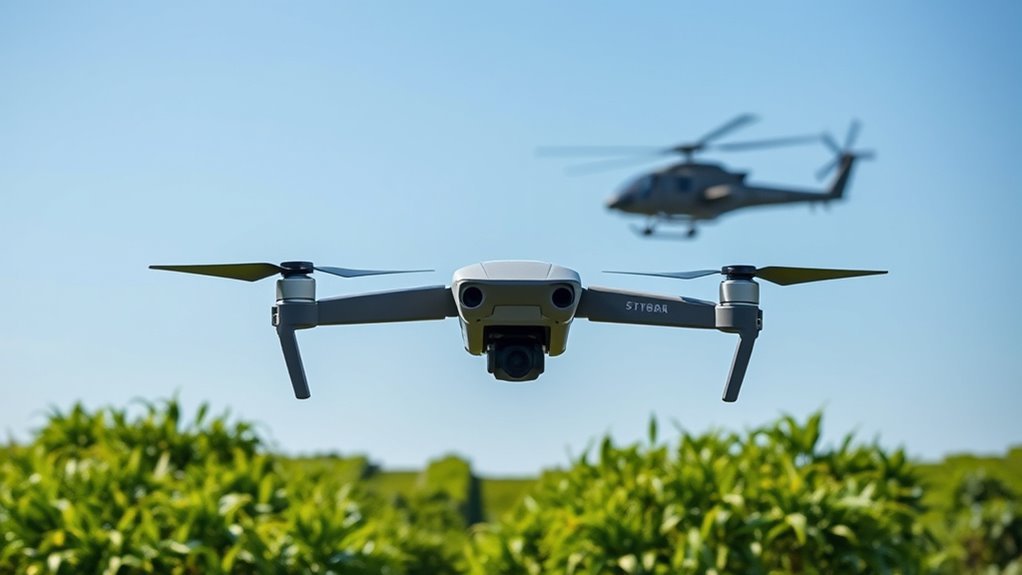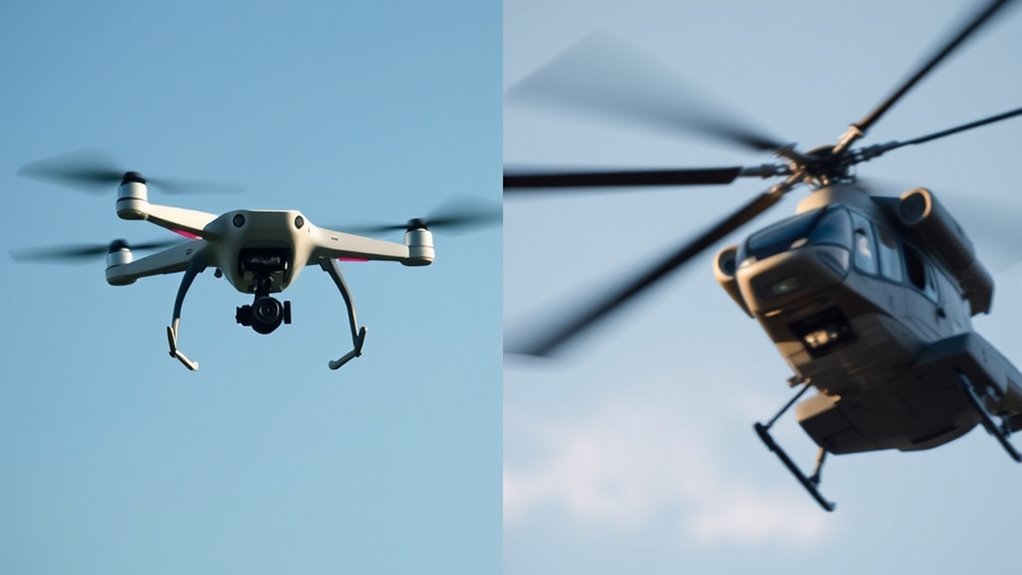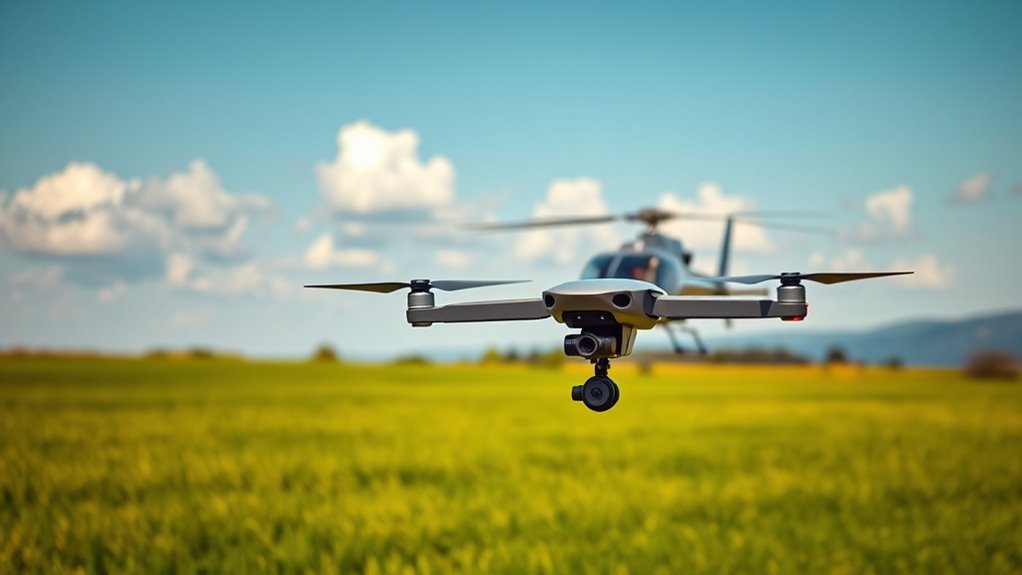Drones sound distinctively different from helicopters. You’ll notice drones produce high-pitched, pulsating noises due to their rapid blade rotations. In contrast, helicopters create a complex thumping sound combined with a continuous roar from their engines. The design and number of rotor blades also play a key role in their acoustic signatures. Understanding these sound characteristics can enhance your appreciation for aerial vehicles, and there’s more to explore regarding the technologies behind these sounds.
The Acoustic Signature of Helicopters

The acoustic signature of helicopters is characterized by a complex interplay of rotor blade movements, engine noise, and aerodynamic effects. Through acoustic analysis, you can discern how these elements contribute to the overall sound profile. The rotor blades generate a distinct thumping noise as they slice through the air, while the engine emits a continuous roar. This combination often exceeds noise regulations, prompting discussions on compliance and mitigation strategies. Understanding these acoustic characteristics not only aids in noise management but also enhances your appreciation for the engineering behind helicopters. As you explore deeper into this subject, consider how these sounds affect urban environments and your own sense of freedom, highlighting the balance between technology and tranquility in the skies.
The Unique Sound of Drones

When you listen to a drone, you’ll notice that its propeller noise is distinctively high-pitched compared to traditional aircraft. This sound results from the rapid rotation of smaller blades and the specific engine characteristics that differ from those of helicopters. Understanding these acoustic properties is essential for analyzing their operational impact in various environments.
Drone Propeller Noise
While many might associate the sound of flying vehicles with the throaty roar of helicopters, drones produce a distinct auditory signature that sets them apart. This sound is primarily generated by their propellers, influenced by drone design and advancements in noise reduction technologies.
Key characteristics of drone propeller noise include:
- Higher frequency: Drones often emit a sharper, higher-pitched sound.
- Pulsating rhythm: The rotation creates a unique cadence that varies with speed.
- Reduced volume: Innovative noise reduction techniques help minimize sound output.
- Directional focus: Drones can create sound patterns that seem to come from specific angles.
Understanding these elements enhances your appreciation of drone technology and its implications for various applications.
Engine Sounds Comparison
Drones produce a unique engine sound that differs considerably from traditional aircraft, especially helicopters. Their electric motors generate a distinct sound frequency, often higher and more consistent than the throaty roar of helicopter engines. This difference stems from the inherent engine efficiency of drones, which rely on quieter, brushless motors.
While helicopters create a complex blend of mechanical and aerodynamic noise, drones tend to emit a more uniform hum, appealing to those seeking a less intrusive experience. The absence of vibration-heavy components in drones allows for a refined sound profile, making them ideal for applications in sensitive environments. Overall, the contrasting engine sounds highlight the technological advancements in drone design, providing a sense of freedom in their operational capabilities.
Comparing Rotor Blade Designs

When comparing rotor blade designs, you’ll notice that both shape and the number of blades markedly influence sound production. The aerodynamic profile of the blades affects airflow, while the quantity alters the frequency and amplitude of the noise generated. Understanding these factors is essential for evaluating the acoustic characteristics of drones versus helicopters.
Rotor Blade Shape
Understanding rotor blade shape is essential for comparing the acoustic profiles of drones and helicopters. The design of rotor blades greatly impacts blade aerodynamics and rotor efficiency, influencing both performance and sound.
- Airfoil Shape: Affects lift and drag characteristics.
- Aspect Ratio: Longer blades can enhance efficiency but may increase noise.
- Blade Tip Design: Shape and materials can minimize vortex shedding.
- Twist and Camber: Optimizes lift distribution along the blade.
Number of Blades
The number of rotor blades greatly influences the acoustic characteristics and overall performance of both drones and helicopters. A higher blade count can enhance lift and stability, which is essential for maneuverability. However, this often results in increased noise levels due to more interaction with the air. Drones typically utilize fewer blades, optimizing for efficiency and noise reduction. For instance, quadcopters balance performance and sound by employing four blades, which minimizes disruptive frequencies. Conversely, helicopters often feature two or more blades, enhancing lift but potentially producing more sound emissions. Understanding these design choices allows you to appreciate how blade count directly impacts not just the drone or helicopter’s operation, but also its acoustic footprint in your environment.
The Impact of Size and Weight on Sound
Although both drones and helicopters are designed for flight, their size and weight considerably influence the sound they produce.
Drones and helicopters differ in sound production, heavily influenced by their size and weight.
- Larger rotors generally create more lift and noise due to increased air displacement.
- Heavier frames amplify vibrations, leading to a deeper, more resonant sound profile.
- Compact designs in drones often result in a higher-pitched, buzzing noise, as smaller propellers spin faster.
- Weight impact affects motor strain, which can alter the frequency and volume of sounds generated.
The size influence of each craft directly correlates to its acoustic output. Understanding these dynamics can help you appreciate the nuanced differences, allowing for a clearer choice in applications requiring discretion or minimal disturbance.
Environmental Factors Affecting Noise Levels
Environmental factors play a significant role in determining noise levels produced by drones and helicopters. You’re likely aware that sound travels differently depending on atmospheric conditions, such as temperature and humidity. Warmer air can enhance sound propagation, increasing the perceived noise level. Surrounding terrain also influences environmental noise; for instance, urban environments with hard surfaces amplify sound pollution, while natural landscapes can absorb it. Wind direction and speed can further alter how noise travels, either masking or amplifying the sound. Additionally, vegetation can act as a buffer, reducing the impact of noise on nearby communities. Understanding these factors can help you appreciate the nuances of sound produced by aerial vehicles in various environments, promoting awareness of their effects on local soundscapes.
The Role of Propulsion Systems
While you might not immediately think about it, the propulsion systems of drones and helicopters greatly influence their noise profiles. Understanding the different propulsion types helps clarify how sound modulation occurs in each vehicle.
- Rotary Wings: Helicopters typically use rotary wings, generating a distinct, resonating sound.
- Propellers: Drones often employ propellers, creating varied acoustic signatures depending on size and speed.
- Electric Motors: Many drones utilize electric motors, which can produce less noise compared to traditional combustion engines.
- Blade Design: The shape and material of blades considerably affect not just lift but also sound output.
Applications and Their Acoustic Implications
The choice between drones and helicopters often hinges on their specific applications, each accompanied by distinct acoustic implications. Drone applications, such as aerial surveying and agriculture, typically produce a quieter, more localized sound profile, allowing for minimal disturbance in populated areas. In contrast, helicopter uses, like emergency medical services or search and rescue, generate louder, more pervasive noise, which can impact surrounding environments considerably. This difference in sound not only affects operational effectiveness but also influences public perception and regulatory considerations. Understanding these acoustic implications helps you choose the right tool for your mission while balancing efficiency and community impact. Additionally, the water-resistant features of drones can enhance their usability in various environmental conditions, permitting operations in wet areas without the added noise of helicopters. Ultimately, selecting between drones and helicopters requires careful consideration of both their intended use and the resulting sound characteristics. Moreover, the design and build quality of drones, such as the modular design of the Freefly Alta 8, can further influence their acoustic signatures during operation.
Future Innovations in Aerial Sound Design
As advancements in technology continue to reshape aerial vehicles, innovations in sound design are emerging as a critical area of focus. The development of sound technology tailored for drones and helicopters can greatly enhance user experience and environmental integration.
- Noise reduction techniques to minimize acoustic footprints
- Adaptive sound profiles that adjust based on flight conditions
- Real-time acoustic feedback for improved navigation and safety
- Sonic camouflage strategies to mask operational sounds
Frequently Asked Questions
How Do Weather Conditions Affect Drone and Helicopter Sounds?
Weather conditions greatly influence sound propagation. Temperature effects can alter sound speed, while wind impact can shift sound direction, making drones and helicopters sound different depending on their environment, affecting your perception of their noise levels.
Can Soundproofing Technology Reduce Noise From Drones and Helicopters?
Imagine a serene landscape, where soundproofing materials embrace your surroundings. By employing advanced noise reduction technologies, you can considerably dampen the disruptive hum of drones and helicopters, allowing you to reclaim your peaceful space.
What Is the Legal Noise Limit for Drones and Helicopters?
You’ll find that noise regulations for drones and helicopters vary by region, often limiting sound measurements to around 55 decibels in residential areas. Understanding these limits can help guarantee compliance while preserving your freedom to operate.
How Do Different Environments Influence the Perceived Sound of Aerial Vehicles?
Different environments greatly influence how you perceive aerial vehicle sounds. In urban landscapes, sounds tend to reflect off buildings, amplifying noise, while in rural settings, open spaces allow sounds to dissipate, resulting in a quieter experience.
Are There Any Health Risks Associated With Drone and Helicopter Noise?
Noise exposure from drones and helicopters can lead to hearing damage, particularly in those frequently near these vehicles. It’s crucial to monitor sound levels to mitigate risks and maintain auditory health in environments with consistent aerial activity.

